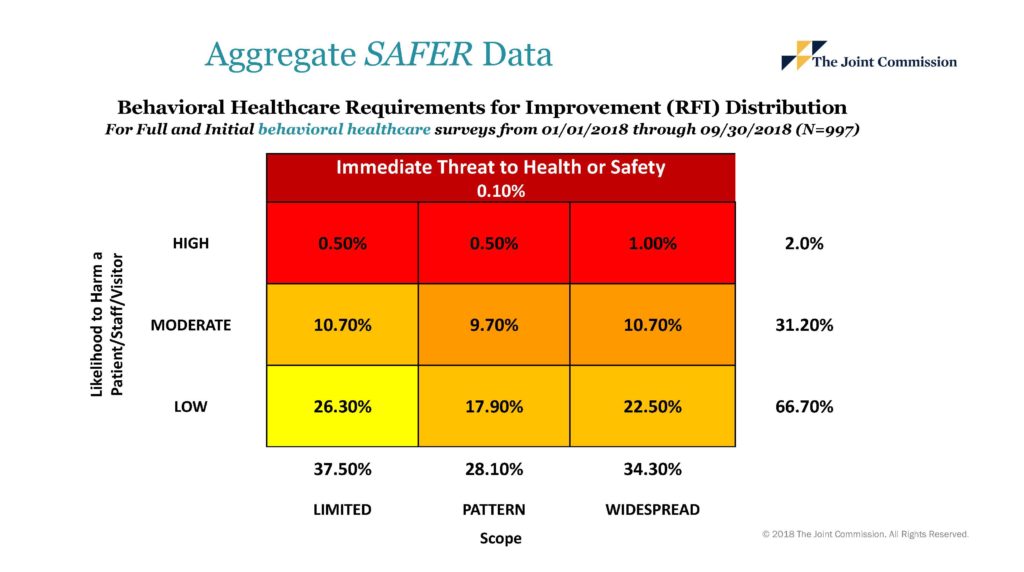In our last post, TJC Survey Outcomes: Update on 2018 Trends, we gave you the scoop on the 2018 survey outcomes for psychiatric hospitals. This time, we’re sharing similar data for behavioral healthcare organizations surveyed under the Behavioral Healthcare Standards manual. Take a look and see how your survey outcomes compare with other behavioral healthcare providers across the country.
TJC Survey Outcomes: 2018 Data for Organizations Surveyed Under BH Standards
From January through September 2018, TJC conducted 997 initial and triennial surveys of behavioral healthcare organizations surveyed under the Behavioral Healthcare Standards manual. The chart below shows the distribution of Requirements for Improvement across the SAFER matrix.

Key Points
- Less than 1% of these organizations received an Immediate Threat to Health/Safety finding.
- The majority of findings (66.7%) were in the Low Risk category.
- Only 1% of these organizations received findings in the High Risk & Widespread category (upper right hand corner of the SAFER matrix.)
Most Frequently Cited Elements of Performance (EPs)
Here’s the Top Ten most frequently cited EPs for this sample of behavioral healthcare organizations:
- Suicide risk assessment NPSG.15.01.01 EP 1
- Nutritional assessment 02.01.11 EP 1
- Treatment plans CTS.03.01.03 EP 3
- Outcomes measurement CTS.03.01.09 EP 1
- Treatment plans CTS.03.01.03 EP 2
- Treatment plans CTS.03.01.03 EP 1
- Verification of credentials HRM.01.02.01 EP 1
- Trauma assessment CTS.02.02.05 EP 2
- Food storage CTS.04.03.33 EP 3
- Utility systems labeling EC.02.05.01 EP 9
So, let’s take a look at some of the high ranking EPs:
Suicide Risk Assessment NPSG.15.01.01 EP 1
A common issue cited for suicide risk assessment was that it did not include environmental features that would increase the suicide risk such as access to guns at home. Another common finding was that the suicide risk assessment had no conclusion regarding the client’s level of suicide risk. These findings are similar for psychiatric hospitals surveyed under the Hospital standards. (See the section below on the Most Frequently Cited High Risk EPs for more info on suicide risk assessment survey findings.)
Nutritional Assessments
Issues with nutritional assessments have been around for a long time in behavioral healthcare organizations. The most common finding last year was that the organization hadn’t updated its nutritional screening criteria to meet the new 2018 requirements. (See our recent post Joint Commission Nutrition Screening Requirements for Behavioral Healthcare Programs.)
Treatment Planning
Three of the top ten clinical findings were for treatment planning. No surprise there! The issues are familiar and are similar to those cited on psychiatric hospital surveys. Treatment plans are not measurable, not individualized, not revised, not related to assessments, etc. (See our recent post Treatment Planning in Behavioral Healthcare: Survey Challenges.)
Outcomes Measurement CTS.03.01.09 EP 1
The common issue we find during our mock surveys is that the organization is not yet using the outcomes data to monitor individual client progress. (For a look at how one organization is doing this, see our post How One Organization is Meeting the New Outcomes Measurement Requirements.)
Most Frequently Cited High Risk Elements of Performance
- Suicide risk assessment NPSG.15.01.01 EP 1
- Environment of Care EC.02.06.01 EP 20
- Ligature and self-harm risks EC.02.06.01 EP 1
- Treatment Plans CTS.03.01.03 EP 1
- Environmental risk assessment EC.02.01.01 EP 1
- Appropriate certification for services provided LD.04.01.01 EP 1
- Secondary means of escape from bedrooms LS.04.01.20 EP 2
- Risk screening procedure CTS.02.01.01 EP 1
- Competency assessment HRM.01.06.01 EP 3
- Policies & procedures LD.04.01.07 EP 1
Top High Risk Element of Performance: Suicide Risk Assessment NPSG.15.01.01 EP 1
Suicide risk assessment tops this list also as the most frequently cited High Risk EP. We see this trend continuing in 2019 so be sure you’re prepared for the new requirements effective July 1st. (See our recent post National Patient Safety Goal NPSG 15.01.01: Q&A on New Requirements.)
Environment of Care and Ligature Risks
Environment of care issues showed up frequently in the Top Ten High Risk EPs. The majority of findings were for ligature risks in inpatient behavioral health settings. Another common finding was that the organization had not completed a thorough environmental risk assessment to identify and mitigate these risks. (See our post Suicide Prevention Recommendations for Non-Hospital Behavioral Health Settings .)
Some other takeaways in this High Risk category: Findings for lack of appropriate certification typically relate to not having a CLIA certificate for waived testing. The Human Resource issues are lack of primary source verification and not documenting initial competency for staff. Inconsistent (or lack of) policies and procedures gets cited under a Leadership standard.
Average Number of Requirements for Improvement
The average number of RFIs for behavioral healthcare organizations from January to September 2018 was 11.5. By comparison, the average for psychiatric hospitals for the same time period was 30.8.
Ongoing TJC Survey Readiness
So, how do these survey outcomes relate to ongoing TJC survey readiness? As the saying goes, “Forewarned is forearmed.” When preparing for your next TJC survey, focus your efforts on these high risk trends. You’ll avoid the predictable findings, the lengthy plans of correction, and the dreaded follow-up surveys. What a welcome outcome! Also, be sure to stay tuned to TJC news alerts such as the new “411 on Survey Enhancements”.


